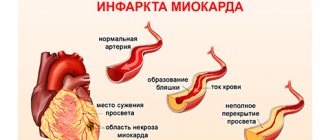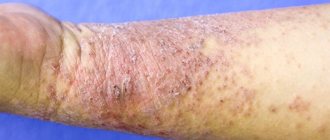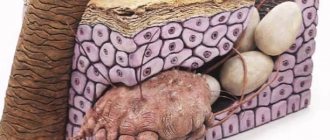Classification of the course of human papillomavirus infection
Once in a woman’s body, HPV can exhibit different activities, depending on the state of the immune system. Depending on how the pathogen behaves, there are several variants of human papillomavirus infection:
- Latent flow. The virus persists in the body, but does not cause pathological changes in cells. There are no symptoms - the presence of a microorganism can only be determined using molecular biological research methods.
- HPV-associated inflammation. As a rule, we are talking about cervicitis or vulvovaginitis due to HPV, which brings the patient to a gynecologist. During the consultation, she can find out how to treat HPV in women. It should be understood that the virus does not cause inflammation on its own, but creates conditions for the activation of the inflammatory process.
- Condylomas located in the anogenital area and on the mucous membrane of the genital tract are a form of PVI (human papillomavirus infection), in which there is a need to use modern surgical techniques to remove formations. After surgical removal, laser destruction, cryodestruction or radio wave coagulation, complex treatment is required to prevent complications and relapses.
- Cervical dysplasia. It may be asymptomatic or provoke discharge. Severe forms of the disease are considered precancerous - to avoid this situation, a correct understanding of how HPV is treated in women is more important than ever.
The classification helps the doctor choose the most effective treatment tactics. Pathogen strains are also divided into groups depending on their ability to cause cancer: HPV with high, medium and low oncogenic risk. Among 40 variants of the virus transmitted through sexual contact, 14 are classified as high and medium oncogenic risk - −16, −18, −31, −33, −35, −39, −45, −51, −52, −56, − 58, −59, −66 and −68 types.
Treatment
Surgery is the main treatment method for papillomatosis. At the same time, traditional excision can cause scarring of the mucosa. To avoid this, gentle intervention methods are used today:
- Removal using laser;
- Ultrasonic disintegration;
- Radiofrequency cold ablation;
- PDT;
- Electrical destruction;
- Cryodestruction;
- Diathermocoagulation and some others.
It is impossible to guarantee the absence of relapse with any of the listed methods. To minimize the risk of relapse after surgery, in some cases, adjuvant drug therapy is prescribed, including antiviral drugs and immunostimulants.
How is human papillomavirus transmitted?
Among the female population, HPV infection reaches 70%. However, the presence of a pathogen in the body does not mean disease. If a person has a healthy immune system, then HPV infection, in most cases, is transient in nature - it disappears on its own within 2 years. If this does not happen, the question of how to treat human papillomavirus in women becomes relevant.
The main route of transmission of the virus is contact:
- sexual;
- vertical (from mother to fetus during childbirth);
- household (using one towel, razor, underwear).
Young people aged 13-30 years are most susceptible to infection with the virus. At the first sexual contact, the risk of infection is about 60%. The virus can also enter the body in the absence of direct intercourse. It is girls who are at maximum risk of encountering HPV, and then its consequences. This is due to the structural features of their genital organs.
Esophageal disease
The pathology is quite rare. The resulting neoplasms resemble polyps or leaf-shaped whitish formations in appearance. Their usual size does not exceed a centimeter. They are localized in the distal parts of the esophagus.
The main reason for the development of this form of the disease is human papillomavirus infection, however, papillomatosis can be observed in its absence.
As a rule, there are no symptoms for a long time, but as the disease develops, it is directly related to:
- Difficulty swallowing;
- Pain behind the sternum;
- Belching;
- Nausea.
This type of disease is considered precancerous, so if it is detected, surgical intervention is necessary.
Human papillomavirus in women: causes
Having become infected with the virus, the body of a healthy woman either quickly gets rid of the pathogen, or the woman becomes an asymptomatic carrier. Among the factors that lead to the virus remaining in the body and causing HPV-associated diseases, the following should be highlighted:
- concomitant pathology of the reproductive system;
- endocrine disorders;
- immunodeficiencies and vitamin deficiencies;
- frequent acute infectious diseases - ARVI, other viral and bacterial infections;
- early sexual intercourse;
- abortions;
- smoking and drinking alcohol;
- chronic psycho-emotional stress, weakening the immune system;
- excessive physical and emotional stress, irregular daily routine;
- postpartum period - due to stress and hormonal changes;
- long-term use of immunosuppressive drugs and oral contraceptives.
Frequently changing sexual partners also increases the risk of both infection with new strains of the virus and intensification of an existing infection. If immunity decreases, the virus is integrated into the cellular genome, which entails a high probability of cancer - how to cure HPV in women at this stage has yet to be discovered by medical science. Therefore, it is so important to keep the activity of the virus under control and properly stimulate the immune defense.
Intraductal disease
In this case, neoplasms arise in the mammary gland, in its milk ducts. As a rule, the formations do not exceed a centimeter, but gigantic ones are also observed - more than five centimeters. The latter deform the mammary gland. Increasing in size, neoplasms contribute to mechanical expansion of the duct, which leads to pain.
Typically, this type of disease affects women between thirty-five and fifty-five years of age. The disease can be caused by:
- Taking oral contraceptives;
- Taking hormonal drugs;
- Family history;
- Endocrinological disorders;
- Chronic inflammatory processes of the appendages.
The symptomatic manifestation of the disease is an amber-colored discharge from the nipple or a discharge mixed with blood.
The patient may complain of discomfort and soreness. Upon palpation, a lump is detected in the mammary gland.
There is a high probability of the neoplasm degenerating into cancer, so if it is detected, surgical treatment is necessary.
The first signs of HPV in women and additional symptoms
The most obvious sign of the presence of HPV in a woman’s body is the appearance of papillomas on the mucous membranes of the genital organs and the skin of the anogenital area. They do not cause pain and, as a rule, go unnoticed for a long time. However, the activity of the virus can provoke the appearance of other unpleasant symptoms, due to which the woman will immediately contact a gynecologist:
- pathological vaginal discharge, accompanied by itching and burning;
- frequent relapses of vaginitis, bacterial vaginosis;
- unpleasant odor of vaginal discharge.
Upon examination, the doctor sees benign formations on the skin, changes in the epithelium of the cervix, and signs of inflammation. Cancer can appear only in the later stages of chronic human papillomavirus infection.
Disease in the larynx
Statistics show that this variant occurs in 2 people out of 100,000 adults and 4 children out of 100,000 people.
Symptoms that characterize this option:
- Hoarseness;
- Breathing disorders.
The development of the disease can lead to:
- Laryngeal stenosis;
- Penetration of papillomas into the trachea and bronchi;
- Development of pulmonary failure;
- Degeneration into a malignant tumor.
Is there a cure for human papillomavirus?
In order to understand how HPV is currently treated in women, you should understand what approaches exist in the treatment of human papillomavirus infection. At the moment, therapy for HPV infection comes down to the following measures:
- prevention of progression of HPV infection;
- elimination of clinical manifestations;
- stimulation of systemic and local antiviral immunity.
There are no drugs that lead to the complete disappearance of the virus from the body. However, research in this area is ongoing - the focus of doctors is on the need for combined treatment of various manifestations of HPV. Research in the field of genetic engineering is promising. Scientists are considering the possibility of “rewriting” the virus code to self-destruct instead of spreading. Reducing viral copies restores local immunity and eliminates chronic inflammation.
Information for doctors on the topic “How to treat HPV in women” is currently described in detail in current clinical guidelines.
When should you see a doctor?
Women should undergo a preventive examination by a gynecologist at least once a year. Also, the need to visit a doctor arises when any disturbing symptoms appear:
- neoplasms in the genital area;
- warts on other areas of the skin and mucous membranes;
- painful sensations in the lower abdomen;
- unusual discharge or unpleasant odor from the vagina;
- itching, swelling, redness of the genitals.
In a situation where accidental sexual intercourse has occurred, it is recommended to visit a gynecologist. He will conduct an examination, take a gynecological smear and scraping to detect HPV.
If papillomas occur in other parts of the body, consultation with a dermatovenerologist is necessary. When papillomas or condylomas grow in the anal area, the intervention of a proctologist may be required. This will help determine treatment tactics and what anti-papilloma medications should be prescribed to the patient in a particular case for purchase at the pharmacy.
General treatment regimen depending on the form of infection
The primary weapon in the fight against HPV is the stable immunity of the person himself. The American Center for Disease Control and Prevention points out that in 90% of cases of contact with the virus, clinical manifestations do not develop due to self-suppression of the virus by natural immunity.
Treatment for HPV infection should be comprehensive and aimed at:
Chronic psycho-emotional stress, poor environment and concomitant diseases reduce the ability of a woman’s immune system to cope with the virus on its own. There are drugs that, by providing a direct antiviral and immunomodulatory effect, help the body’s strength and lead to a reduction in the viral load. Such modern drugs include Epigen Intim Spray. Activated glycyrrhizic acid, obtained from licorice root, helps interrupt viral replication in the early stages and reduce the number of copies of HPV genetic material in the body. The product has a special intravaginal nozzle for delivering the medicine to the cervix and distributing it evenly along the vaginal walls. Antiviral and immunomodulatory therapy for latent papillomavirus infection can prevent the appearance of unpleasant symptoms and the transition of infection to more aggressive forms. If the virus has provoked changes in the genital area and cervical epithelium, Epigen Intim Spray helps:
- relieve inflammation;
- eliminate itching;
- restore the integrity of the mucosa;
- increase local immunity.
The use of the product is also indicated during the period of preparation for the removal of benign formations caused by HPV, to reduce the activity of the virus and prevent relapses. The drug promotes skin regeneration and prevents secondary infections.
Skin disease
This is the growth of many skin tumors in a local area. The usual size of skin papillomas is 5–7 millimeters, but neoplasms up to 2 centimeters can be found.
The shape of the neoplasm resembles dotted or slightly drooping skin growths or peas. Usually the color of the growth is exactly the same as the skin around it, but new growths of brown and white colors are observed.
Typical localization of neoplasms is the back, palms, fingers, soles, feet, eyelids, neck, axillary and inguinal areas.
The disease, as a rule, has no symptoms; its danger is that injured tumors can cause inflammation or turn into malignant tumors.
Removal of papillomas and warts
Benign formations caused by HPV must be removed, which can be done using the following methods:
- cryodestruction - exposure to cold on a tumor;
- electrocoagulation - treatment with high frequency current;
- laser removal - layer-by-layer exposure to laser irradiation until a scab appears;
- chemical destruction - treatment with special chemical solutions that are applied to condylomas and destroy them;
- surgical removal - given the high risk of relapse after this type of destruction, it is prescribed selectively - if it is impossible to use other methods.
To prevent relapses and complications after all types of destruction, complex treatment is prescribed. Treatment with antiseptics is necessary to prevent infection of the healing surgical site. Glycyrrhizic acid (Epigen Intim Spray) is prescribed to suppress the activity of the virus, improve immune defense and stimulate regenerative processes. If the patient has a weakened immune system, he is referred to a consultation with an immunologist.
Among the new developments in the treatment of HPV is the CRISPR/Cas9 system, which almost completely cuts DNA and inserts its own sections, thereby inactivating the further spread of the virus.
Diagnostic measures
Often the disease is detected during the initial examination, because neoplasms have characteristic forms - a soft, dense tumor on a stalk, the size of which usually ranges from a centimeter to two. The tumor has an uneven outer surface, its color is white or brown. Sometimes the overgrown tumor looks like cauliflower.
The choice of instrumental diagnostic methods is influenced by the localization of the disease:
- Larynx – laryngoscopy;
- Esophagus – endoscopy;
- Mammary gland - ductography.
In order to confirm the viral origin of the neoplasm and determine its specific type, it is necessary to study using laboratory techniques - polymerase chain reaction, hybridization methods.
An assessment of the patient’s immune status is important in complex treatment; it is used both when prescribing drug therapy and for preventive measures.
Prevention
For the purpose of primary prevention, it is recommended to use barrier contraception (condoms), which, although not absolute protection against HPV, will reduce the level of contact with the virus. You should be selective when choosing sexual partners. If a casual relationship does occur, Epigen Intim spray can be used to protect against HPV, herpes simplex virus and cytomegalovirus infection.
Today, HPV vaccine prevention is the most effective. It protects against the most common and malignant types of human papillomavirus. In many countries, HPV vaccination is included in the mandatory vaccination schedule. The most effective time for vaccination is childhood and adolescence. Previously, it was believed that after 20 years of age, vaccination does not make sense. But recent studies have shown that HPV vaccination is appropriate and effective up to 45-47 years of age.
If infection with the virus does occur, the task of secondary prevention is to maintain good health of the patient, in particular the good state of his immune system. Women need to regularly visit a gynecologist to identify virus-associated diseases in the early stages.










